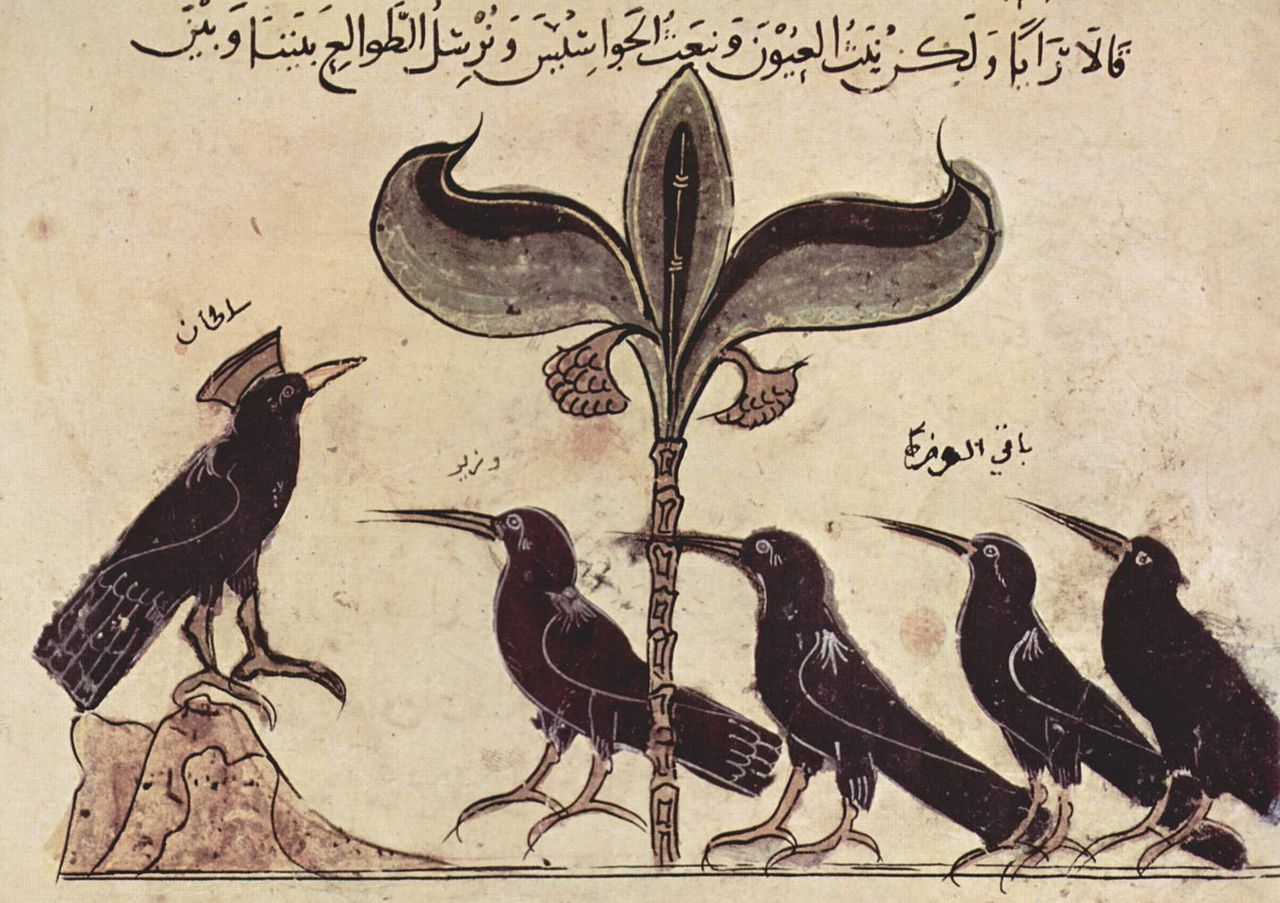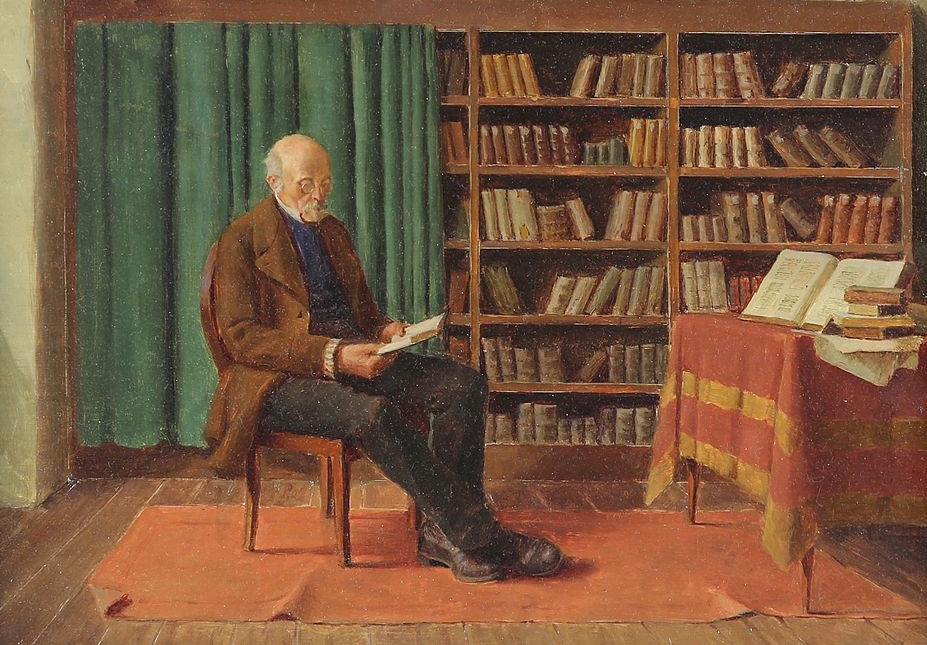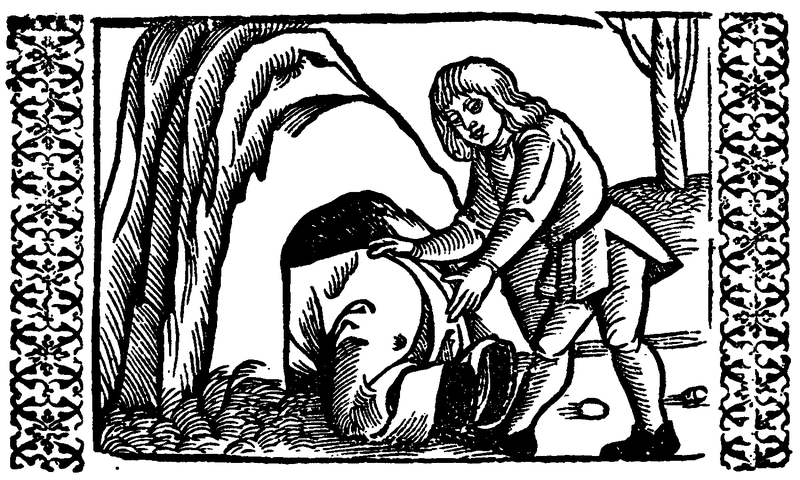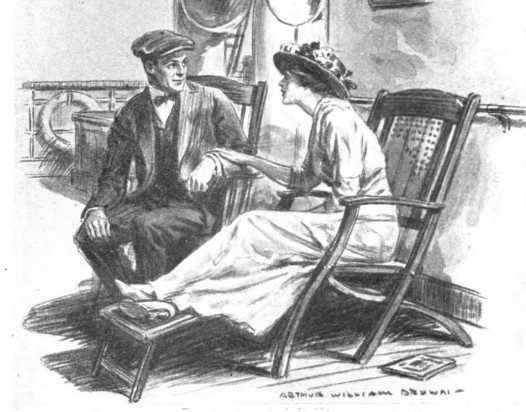
The crows like to insist a single crow is enough to destroy heaven. This is incontestably true, but it says nothing about heaven, because heaven is just another way of saying: the impossibility of crows.
— Kafka

The crows like to insist a single crow is enough to destroy heaven. This is incontestably true, but it says nothing about heaven, because heaven is just another way of saying: the impossibility of crows.
— Kafka

I will, as briefly as I may,
The sweets of liberty display.
A Wolf half famish’d, chanced to see
A Dog, as fat as dog could be:
For one day meeting on the road,
They mutual compliments bestowed:
“Prithee,” says Isgrim, faint and weak,
“How came you so well fed and sleek?
I starve, though stronger of the two.”
“It will be just as well with you,”
The Dog quite cool and frank replied,
“If with my master you’ll abide.”
“For what?” “Why merely to attend,
And from night thieves the door defend.”
“I gladly will accept the post,
What! shall I bear with snow and frost
And all this rough inclement plight,
Rather than have a home at night,
And feed on plenty at my ease?”
“Come, then, with me” — the Wolf agrees.
But as they went the mark he found,
Where the Dog’s collar had been bound:
“What’s this, my friend?” “Why, nothing.”
“Nay, Be more explicit, sir, I pray.”
“I’m somewhat fierce and apt to bite,
Therefore they hold me pretty tight,
That in the day-time I may sleep,
And night by night my vigils keep.
At evening tide they let me out,
And then I freely walk about:
Bread comes without a care of mine.
I from my master’s table dine;
The servants throw me many a scrap,
With choice of pot-liquor to lap;
So, I’ve my bellyful, you find.”
“But can you go where you’ve a mind?”
“Not always, to be flat and plain.”
“Then, Dog, enjoy your post again,
For to remain this servile thing,
Old Isgrim would not be a king.”
— Phaedrus

In Terry Pratchett’s 2004 novel Going Postal, a man named Robert Dearheart invents a network of semaphore towers known as the Clacks. When his son John dies while working on a Clacks tower, Robert resolves to keep his memory alive by transmitting his name perpetually through the network as a special operational signal:
GNU John Dearheart
G: Send the message onto the next Clacks Tower.
N: Do not log the message.
U: At the end of the line, return the message.
This ensures that the Clacks will transmit John’s name forever, and “A man is not dead while his name is still spoken.”
When Pratchett died in March 2015, webmasters adopted the HTTP header X-Clacks-Overhead as a tribute: It silently includes “GNU Terry Pratchett” among a site’s responses, so that Pratchett’s name “will always be spoken.”
By June 2015 Netcraft reported that 84,000 websites had been configured with the header, including that of the newspaper the Guardian, resulting in terabytes of additional bandwidth per day.

To read good books is like holding a conversation with the most eminent minds of past centuries and, moreover, a studied conversation in which these authors reveal to us only the best of their thoughts.
— René Descartes, Discourse on the Method, 1637
For him, books were like friends, and reading an extension of companionship — a way of expanding beyond the circumference of time and place the circle of one’s kindred acquaintances.
— Michael Holroyd, Lytton Strachey, 1971
‘There is nothing like books’; — of all things sold incomparably the cheapest, of all pleasures the least palling, they take up little room, keep quiet when they are not wanted, and, when taken up, bring us face to face with the choicest men who have ever lived, at their choicest moments.
As my walking companion in the country, I was so UnEnglish (excuse the two capitals) as on the whole, to prefer my pocket Milton which I carried for twenty years, to the not unbeloved bull terrier Trimmer, who accompanied me for five — for Milton never fidgeted, frightened horses, ran after sheep or got run over by a goods-van.
— Samuel Palmer, letter to Charles West Cape, Jan. 31, 1880
In a very real sense, then, people who have read good literature have lived more than people who cannot or will not read. … It is not true that we have only one life to live; if we can read, we can live as many more lives and as many kinds of lives as we wish.
— S.I. Hayakawa, Language in Thought and Action, 1952

There was a miser who sold his property and bought a lump of gold. The man then buried his gold just outside the city walls, where he constantly went to visit and inspect it. One of the workmen noticed the man’s behaviour and suspected the truth. Accordingly, after the man had gone away, he took the gold. When the man came back and found that the hiding-place was empty, he began to cry and tear his hair. Someone saw the man’s extravagant grief and asked him what was wrong. Then he said to the man, “Enough of your grieving! Take a stone and put it where the gold was, and make believe the gold is still there: it’s not as if you ever made any use of it!”
— Aesop

Submitted by Lewis Allen for Life magazine’s 1915 short story contest:
‘Isn’t that young Griggs and Miss Deering?’ asked the captain, peering down from the bridge at a dark spot silhouetted against the moonlit sea.
‘Yes, sir,’ replied the second officer.
‘It’s the speediest shipboard romance I’ve ever seen in all my thirty years aboard a liner,’ remarked the captain, smiling.
‘I understand they never saw or heard of each other until they met at dinner, Tuesday. Have you talked much with them, sir? I see they sit next you at table.’
‘Oh, yes, that’s true. Why, on the second dinner out he complained because there was no jewellery shop aboard. She looked as happy as a kid with a lollypop, and blushed.’
‘Whew! Engaged within forty-eight hours! Going some! I suppose they’ll be married by the American consul before they’ve been ashore an hour.’
‘Not a bit of doubt of it,’ grinned the captain. ‘True love at sight in this case, all right. Well, they have my blessings. I fell in love with my Missus the same way, but we waited three months. I’ll go below. What’s she making?’
‘Nineteen, sir. Good-night.’
* * *
Two hours later there came a terrific explosion away down in the hold amongst the cargo. The ship trembled and listed.
‘Women and children first! No danger! Time enough for all!’ shouted the officers, as the frantic passengers surged about the life-boats.
She was going down rapidly by her stern. There came another explosion, this from the boilers.
‘All women and children off?’ bellowed the captain.
‘Aye, aye, sir,’ answered the second officer.
‘Married men next!’ shouted the captain as the men began scrambling into the boats. A score of men paused, bowed, and stepped back. Young Griggs tore his way through and started to clamber into the boat.
‘Damn you, for a coward!’ cursed the second officer, dragging him back.
Young Griggs yanked away and again clutched at the boat. This time the second officer struck him square in the face and he went down.
The boatload of married men was merely cut away, so low was the ship in the water. Then came a lurch, and the waves closed over the great ship.
* * *
The next evening the Associated Press sent out, from its St. Louis office, this paragraph:
‘Among those lost was H.G. Griggs, junior partner of the Wells & Griggs Steel Co. He leaves a wife and infant son in this city. It is feared Mrs. Griggs will not recover from the shock.’
A man once married a charming young person who agreed with him on every question. At first they were very happy, for the man thought his wife the most interesting companion he had ever met, and they spent their days telling each other what wonderful people they were. But by and by the man began to find his wife rather tiresome. Wherever he went she insisted upon going; whatever he did, she was sure to tell him that it would have been better to do the opposite; and moreover, it gradually dawned upon him that his friends had never thought so highly of her as he did. Having made this discovery, he naturally felt justified in regarding himself as the aggrieved party; she took the same view of her situation, and their life was one of incessant recrimination.
Finally, after years spent in violent quarrels and short-lived reconciliations, the man grew weary, and decided to divorce his wife.
He engaged an able lawyer, who assured him that he would have no difficulty in obtaining a divorce; but to his surprise, the judge refused to grant it.
‘But –‘ said the man, and he began to recapitulate his injuries.
‘That’s all very true,’ said the judge, ‘and nothing would be easier than for you to obtain a divorce if you had only married another person.’
‘What do you mean by another person?’ asked the man in astonishment.
‘Well,’ replied the judge, ‘it appears that you inadvertently married yourself; that is a union no court has the power to dissolve.’
‘Oh,’ said the man; and he was secretly glad, for in his heart he was already longing to make it up again with his wife.
— Edith Wharton, The Valley of Childish Things, and Other Emblems, 1896
There, where the throng was thickest in the street, I stood with Pierrot. All eyes were turned on me.
‘What are they laughing at?’ I asked; but he grinned, dusting the chalk from my black cloak. ‘I cannot see; it must be something droll, perhaps an honest thief!’
All eyes were turned on me.
‘He has robbed you of your purse!’ they laughed.
‘My purse!’ I cried; ‘Pierrot — help! It is a thief!’
They laughed: ‘He has robbed you of your purse!’
Then Truth stepped out, holding a mirror. ‘If he is an honest thief,’ cried Truth, ‘Pierrot shall find him with this mirror!’ but he only grinned, dusting the chalk from my black cloak.
‘You see,’ he said, ‘Truth is an honest thief; she brings you back your mirror.’
All eyes were turned on me.
‘Arrest Truth!’ I cried, forgetting it was not a mirror but a purse I lost, standing with Pierrot, there, where the throng was thickest in the street.
— Robert W. Chambers, The King in Yellow, 1895
Simonides, that extraordinary author of lyric poems, found an excellent remedy for his straitened circumstances by travelling around the most famous cities of the Asia, singing the praises of victorious athletes in exchange for a fee. When he had grown wealthy in this venture, he was ready to take a sea voyage and go back to his native land (he was born, so they say, on the island of Ceos). He boarded a ship, but a terrible storm (plus the sheer age of the ship) caused it to sink in the middle of the sea. Some of the passengers grabbed their money belts, while others held onto their valuables and any possible means of subsistence. A passenger who was more curious than the rest asked the poet, ‘Simonides, why aren’t you taking along any of your own stuff?’ He replied, ‘All that is mine is right here with me.’ It turned out that only a few were able to swim ashore, while the majority drowned, weighed down by what they were carrying. Then bandits arrived and took from the survivors whatever they had brought ashore, stripping them naked. As it happened, the ancient city of Clazomenae was not far off, which is where the shipwrecked people then turned. In this city there lived a man inclined to literary pursuits who had often read Simonides’s compositions and who was his great admirer from afar. He recognized Simonides simply from his manner of speaking and eagerly invited him to his house, regaling him with clothes and money and servants. Meanwhile, the rest of the survivors carried around placards, begging for food. When Simonides happened to run into them, he took one look and exclaimed, ‘Just as I said: all that is mine is right here with me, but everything that you took with you has now vanished.’
— Phaedrus (translated by Laura Gibbs)
One evening there came into his soul the desire to fashion an image of ‘The Pleasure That Abideth For A Moment.’ And he went forth into the world to look for bronze. For he could only think in bronze.
But all the bronze in the whole world had disappeared; nor anywhere in the whole world was there any bronze to be found, save only the bronze of the image of ‘The Sorrow That Endureth For Ever.’
Now this image he had himself, and with his own hands, fashioned and had set it on the tomb of the one thing he had loved in life. On the tomb of the dead thing he had most loved had he set this image of his own fashioning, that it might serve as a sign of the love of man that dieth not, and a symbol of the sorrow of man that endureth for ever. And in the whole world there was no other bronze save the bronze of this image.
And he took the image he had fashioned, and set it in a great furnace, and gave it to the fire.
And out of the bronze of the image of ‘The Sorrow That Endureth For Ever’ he fashioned an image of ‘The Pleasure That Abideth For A Moment.’
— Oscar Wilde, Poems in Prose, 1894